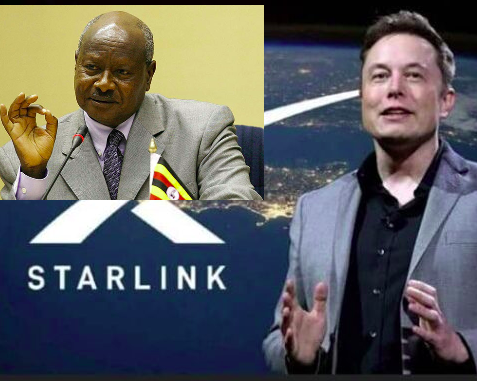President Yoweri Museveni announced that Uganda is ready to welcome Starlink, a satellite internet service owned by Elon Musk’s SpaceX. This decision is a big step toward improving internet access across the country, especially in rural areas where connectivity has been a challenge for years. It shows Uganda’s commitment to using modern technology to close the digital gap and grow its digital economy.
Museveni shared the news after a high-level meeting at Nakasero State Lodge with Starlink representatives Ben MacWilliams and Brandi Oliver. The meeting was arranged with the help of Uganda’s Ambassador to the United States, Adonia Ayebare, and the U.S. Ambassador to Uganda, William Popp. Both diplomats have worked to strengthen ties between Uganda and the United States, especially in technology and development projects. In a post on X, Museveni expressed his support for Starlink’s plans, saying, “Yesterday in Nakasero, I had a productive meeting with Starlink representatives… I appreciate their commitment to providing low-cost internet in hard-to-reach areas and establishing a presence in Uganda. They are welcome.” His words show excitement about Starlink’s potential to bring affordable and reliable internet to parts of Uganda that have been left behind.
Starlink is a global internet service run by SpaceX, a company founded by Elon Musk. Starlink uses a network of thousands of low-Earth orbit satellites, unlike traditional internet providers that use cables or cell towers. These satellites are closer to Earth than older satellite systems, so they can provide faster internet with less delay. This technology is especially useful for rural and remote areas where building cable or fiber networks is expensive or difficult. Starlink aims to offer high-speed internet, with speeds from 50 to 500 Mbps, that supports streaming, online learning, video calls, and even gaming. In Uganda, where many people rely on mobile data from companies like MTN and Airtel, Starlink could provide a faster and more reliable option, especially in areas with poor network coverage.
For years, Uganda has struggled with uneven internet access. A 2022 National Information Technology Authority survey showed that about 94% of households, mostly in rural areas, do not have internet access. Only 13% of urban households have a working internet connection, compared to just 3.2% in rural areas. This gap has made it hard for people in remote regions to access online education, healthcare services, or business opportunities. Starlink’s entry could change this by providing internet to hard-to-reach areas, helping students with e-learning, farmers check market prices, and small businesses reach customers online. It could also support Uganda’s growing digital economy, including e-commerce, telemedicine, and remote work. Museveni’s approval shows that the government sees Starlink as part of its plan to modernize the country and achieve its “Uganda 2030” development goals.
This decision is a key part of Uganda’s digital transformation strategy, which aims to make technology a driver of economic growth. Starlink has already applied for a license from the Uganda Communications Commission, the body that regulates telecommunications in the country. While it is not yet clear if the license has been fully granted, the President’s public support suggests that Starlink is close to starting operations. Starlink is already active in 17 African countries, including Nigeria, Kenya, Rwanda, and Somalia, where it has provided faster internet to rural communities, improving education, healthcare, and business. Uganda could soon join this list, becoming a leader in East Africa for satellite-based connectivity.
However, Starlink may face some challenges. In other African countries, telecom companies like Safaricom in Kenya have raised concerns about Starlink’s lack of local investment in jobs or infrastructure. In Uganda, major players like MTN and Airtel dominate the internet market with mobile data and fiber services. These companies have invested heavily in building networks and may see Starlink as a competitor. Some worry that Starlink’s ability to operate without physical offices could make it harder for regulators to ensure fair competition. Another challenge is cost. In countries like Kenya, Starlink’s monthly subscription is around UGX 403,000, with hardware costs starting at UGX 460,000. This is expensive compared to local mobile data plans, which can cost as little as UGX 1,000 for 1GB. For Starlink to succeed in Uganda, it may need to offer pricing that fits the local economy, especially for rural users.
The approval of Starlink shows that Uganda is open to new ideas and global partnerships. The involvement of U.S. diplomats in the Nakasero meeting highlights the growing cooperation between Uganda and the United States in technology and innovation. As Starlink moves closer to launching, many Ugandans are hopeful that it will bring better internet to millions, helping to create jobs, improve education, and connect communities. For now, people are waiting to see when Starlink will officially start and what it will cost. If successful, this could be a game-changer, making Uganda a more connected and competitive player in the digital world. As one X user said, “Embracing satellite internet has the potential to transform rural connectivity, enhance education, health services, and boost innovation across the country.”

1 comment
When is it starting